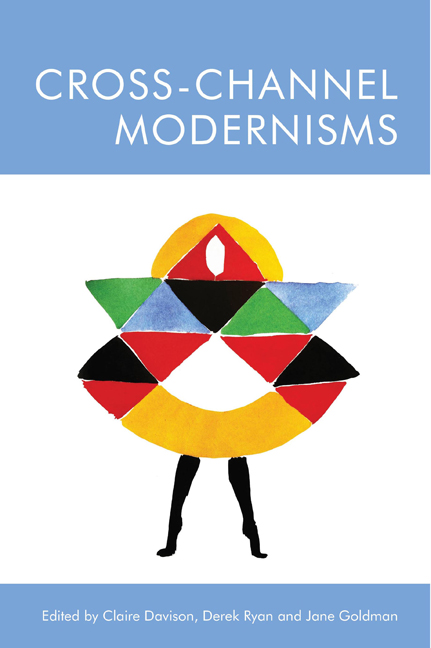Book contents
- Frontmatter
- Contents
- List of Figures
- Notes on Contributors
- Introduction: Cross-Channel (Transmanche) Modernisms
- Interlude: Translating
- 1 On Unknowing French? Rhythm and Le Rythme on a Cross-Channel Exchange
- 2 Impressions of Translation: Ford Madox Ford’s Cosmopolitan Literary Crossings
- 3 Sydney Schiff and Marcel Proust: Table-talk, Tribute, Translation
- Interlude: Fashioning
- 4 Cross-Channel Modernisms and the Vicissitudes of a Laughing Torso: Nina Hamnett, Artist, Bohemian and Writer in London and Paris
- 5 Jean Rhys’s comédie anglaise
- 6 Betray to Become: Departure in James Joyce’s A Portrait of the Artist as a Young Man
- Interlude: Mediating
- 7 Close Up and Cross-Channel Cinema Culture
- 8 Debussy at the Omega Workshops
- 9 Across the Other Channel: Elizabeth Bowen and Modernist Mediation
- Coda: ‘You, who cross the Channel’: Virginia Woolf, Departures and the Spectro-Aesthetics of Modernism 215
- Index
5 - Jean Rhys’s comédie anglaise
Published online by Cambridge University Press: 03 October 2020
- Frontmatter
- Contents
- List of Figures
- Notes on Contributors
- Introduction: Cross-Channel (Transmanche) Modernisms
- Interlude: Translating
- 1 On Unknowing French? Rhythm and Le Rythme on a Cross-Channel Exchange
- 2 Impressions of Translation: Ford Madox Ford’s Cosmopolitan Literary Crossings
- 3 Sydney Schiff and Marcel Proust: Table-talk, Tribute, Translation
- Interlude: Fashioning
- 4 Cross-Channel Modernisms and the Vicissitudes of a Laughing Torso: Nina Hamnett, Artist, Bohemian and Writer in London and Paris
- 5 Jean Rhys’s comédie anglaise
- 6 Betray to Become: Departure in James Joyce’s A Portrait of the Artist as a Young Man
- Interlude: Mediating
- 7 Close Up and Cross-Channel Cinema Culture
- 8 Debussy at the Omega Workshops
- 9 Across the Other Channel: Elizabeth Bowen and Modernist Mediation
- Coda: ‘You, who cross the Channel’: Virginia Woolf, Departures and the Spectro-Aesthetics of Modernism 215
- Index
Summary
Jean Rhys crossed the Channel (in 1919) and channelled what we now call modernism, and what she called writing, by accident; as she wrote to her friend Peggy Kirkaldy on 6 December 1949:
Now I’m really hanging on to my belief in fate – I never wanted to write. I wished to be happy and peaceful and obscure. I was dragged into writing by a series of coincidences – Mrs Adam, Ford, Paris – need for money. I tried to stop – again I’ve been dragged back. (Rhys 1984: 65)
Modernist malgré elle, artist mostly manqué, out of place, out of sync, out of sight for long decades of (self-imposed) obscurity, out of which she was ‘dragged back’ with the unexpected success of Wide Sargasso Sea in the 1960s, Rhys was always unprepared for the limelight, which, as she later intoned, came too late. Little did she know at the time that both the backward look and the use of the passive voice (‘I was dragged into writing’) would go on to become a signature style, proposed by her scholarly readers as key attributes of her unique blend of modernism.
Ella Gwendolyn Rees Williams was taken to Paris by her first husband, the Dutch writer and journalist Willem Johan Marie (called Jean) Lenglet. According to Martien Kappers-den Hollander,
Lenglet wrote, and sometimes travelled, under the name of Edouard de Nève, a combination of his elder brother's Christian name and the surname he had once seen linked up with his own (as Lenglet de Nève) in Northern France. When his wife in turn needed a literary pseudonym, she concocted it out of her husband's nickname and that of her Welsh-born father: Jean Rhys. (Kappers-den Hollander 1984: 159)
But it was to help Jean make a name for himself that Jean was first dragged into writing. Before she met Ford Madox Ford, Rhys was matronised by Mrs H. Pearl Adam, a journalist she had met in London years before. Mrs Adam was eight years older than Jean and married to George Adam, the Times correspondent in Paris. She stayed with her for a while in 1922 just after the birth of her daughter, whom she eventually gave up for adoption.
- Type
- Chapter
- Information
- Cross-Channel Modernisms , pp. 120 - 137Publisher: Edinburgh University PressPrint publication year: 2020



